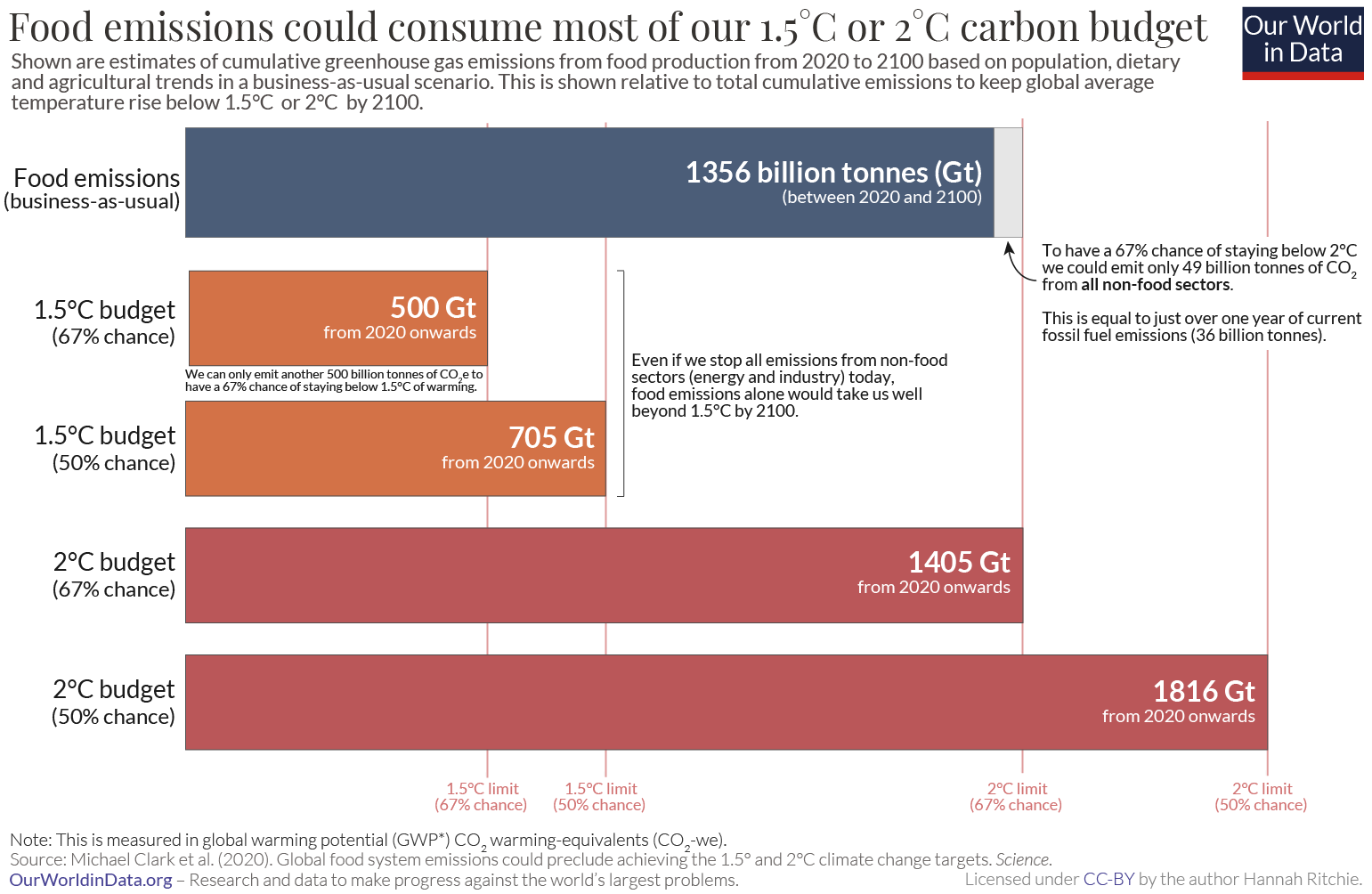Our World in Data presents the data and research to make progress against the world’s largest problems.
This blog post draws on data and research discussed in our entry on Environmental impacts of food production.
In an article published by Hannah Ritchie on Our World in Data, it has been stated that to address global climate change we need to rapidly reduce global greenhouse gas emissions. This often raises debate of where our attention should be: do we focus on energy or food; fossil fuels or meat? But this is a false dichotomy. If we don’t achieve large changes to both, then we stand little chance of coming close to our climate targets. We don’t have the option of neglecting one or the other.
Energy accounts for two-thirds to three-quarters of global greenhouse gas emissions. Getting off of fossil fuels should be our top priority.
But equally, as we will see in this article, even if we reduce non-food emissions to zero tomorrow, emissions from food production alone could hinder our chances of keeping temperature rise below 1.5°C or 2°C by the end of the century. Ignoring food emissions is also not an option.
In this article, the author take a look at projections of emissions from food over the coming century, and what options we have to reduce them.
One-quarter to one-third of global greenhouse gas emissions come from our food systems. These emissions come from various sources: deforestation and land use change; emissions from fertilizers and manure; methane from cattle; methane from rice production; energy use on the farm; supply chain emissions from food processing, refrigeration; and transport.
In a paper published in Science, Michael Clark and his colleagues looked at how food emissions might evolve over the coming century, and they studied whether these would be compatible with our global climate targets.
Let’s consider the scenario that we continue along a similar pathway to the past: their business-as-usual projection. This assumes that global population increases in line with the UN’s medium fertility scenario; per capita diets change as people around the world get richer (shifting towards more diverse diets with more meat and dairy); crop yields continue to increase in line with historical improvements; and rates of food loss and the emissions intensity of food production remain constant.
In the chart we see estimates of the cumulative emissions from food from 2020 through to 2100 under this scenario. Emissions here are calculated based on a metric called “global warming potential CO2 warming-equivalents (CO2-we)”. This accounts for the range of greenhouse gases, not just CO2 but also others such as methane and nitrous oxide. This is shown in comparison to our total carbon budgets for 1.5°C or 2°C. The budgets are based on the thresholds set in the IPCC’s Special Report on Global Warming of 1.5°C to have a 67% and 50% chance of meeting our 1.5°C and 2°C targets.
In the business-as-usual scenario the authors expect the world to emit around 1356 billion tonnes of CO2-we by 2100. This would take us well beyond the carbon budget for 1.5°C – we would emit two to three times more. Let’s be clear on what this means: if we stopped burning fossil fuels tomorrow and eliminated all other emissions, food production alone would take us past our 1.5°C target by mid-century.
What about 2°C? There we have a bit more room in our budget. But, food emissions would consume nearly all of it. To have a 67% chance of staying below 2°C, we have to keep cumulative emissions below 1405 billion tonnes. After food emissions, there would be only 49 billion tonnes left to share between all non-food sectors. That’s not 49 billion tonnes per year; that’s 49 billion tonnes split over 80 years. This is equal to just over one year of current fossil fuels emissions. If we wanted to meet our target we would have one year to move to a zero-carbon energy system.
If we wanted to give ourselves a bit more room, and hope for a 50% chance of keeping below 2°C, we would have to reduce all non-food emissions to zero within 10 to 12 years.5
Ignoring food emissions is simply not an option if we want to get close to our international climate targets. Even if we stopped burning fossil fuels tomorrow – an impossibility – we would still go well beyond our 1.5°C target, and nearly miss our 2°C one.
How can we reduce greenhouse gas emissions from food production?
Following scenarios has been discussed in the article to reduce the greenhouse gas emissions:
- High Yields
- Halve Food Waste and Losses
- Healthy Calories
- Best Farm Practices
- Plant Rich Diet
To get more information on how 350 PPM Ltd is helping in reducing these emissions, register your interest on My Healthy Kick’s website:
To read the complete article, please click below:
